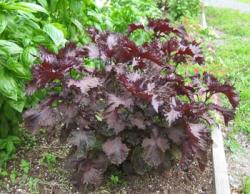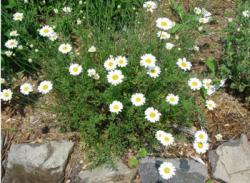Your search for Herbs begining with the letter P returned 10 items.
A | B | C | D | E | F | G | H | I | J | K | L | M | N | O | P | Q | R | S | T | U | V | W | X | Y | Z
Papalo Quinquina/ Papaloquelette.
Porophyllum ruderale subsp. macrocephalum. Annual. Sometimes called quinquina. This cilantro substitute rarely flowers before our first killing frost so leaf production is constant. Can grow up to six feet tall. Flavor is a combination of cilantro, green pepper, cucumber, and citrus. Native from Texas to South America. Use leaves torn fresh in beans, or with tortillas and garlic.Last Seed Source: www.johnnyseeds.com
Par Cel.
Apium graveolens. Biennial, hardy to -10°F. A cut and come again vegetable celery that looks and grows like a curly leaf parsley. All the flavor of celery but does not form large stalks.Last Seed Source: www.johnnyseeds.com
Parsley, Curly.
Petroselinum crispum 'Moss Curled II'. Biennial. Nicely flavored and decorative. Parsley plants grow quickly and they can be cut for use when they are only a few inches high. Some summer shade will create a lushness unobtainable in full, drying summer sun. Cut stems often and remove old, yellowing leaves. Provide ample water to keep plants from wilting and fertilize with liquid or slow release nutrients.Last Seed Source: www.johnnyseeds.com
Parsley, Giant Italian.
Petroselinum crispum var. neapolitanum. Biennial. This is the flat-leaved parsley called Prezzemolo gigante d'Italia in Italy. Ours is the true Catalogna cultivar, not to be confused with the more ordinary flat-leaved parsley. This parsley has large, flat leaves that look like celery and is accompanied by the finest flavor. Stems may be eaten like celery. Plants mature quickly and may reach 2 feet high.Last Seed Source: www.johnnyseeds.com
Parsley, Japanese.
Cryptotaenia japonica. Mitsuba, as the Japanese call it, is not a true parsley. In appearance it resembles a flat leafed Italian parsley. Its mild flavor is essential to many oriental dishes and it can be substituted wherever a recipe requires parsley. Unlike parsley, Mitsuba is a hardy perennial.Last Seed Source: www.richters.com
Passion Flower.
Passiflora incarnata. PassionflowerPatchouli.
Pogostemom cablin. Frost sensitive perennial. It does not need strong sunlight (it is often cultivated commercially under rubber trees) and can be grown easily indoors during winters. Height to 4 feet. Tiny white flowers are produced on spikes in late fall and winter.Perilla, Green.
Perilla frutescens. This Japanese annual, sometimes called "Beefsteak Plant" or "Shiso", is hardy to about 30°F. Height: 2 to 3 feet. Plants are colorful and decorative. Their large leaves are deeply toothed and carry an anise scent, creating a resemblance to basil for which they are often mistaken. They are used in a wide variety of dishes, including bean curd, tempura, and sushi. We carry both the green and purple varieties of Perilla.Last Seed Source: www.johnnyseeds.com
Perilla, Purple.
Perilla frutescens. This Japanese annual, sometimes called "Beefsteak Plant" or "Shiso", is hardy to about 30°F. Plants grow to about 2 to 3 feet tall and are colorful and decorative. Their large leaves are deeply toothed and carry an anise scent, creating a resemblance to basil for which they are often mistaken. They are used in a wide variety of dishes, including bean curd, tempura, and sushi.Last Seed Source: www.johnnyseeds.com
Pyrethrum, Kenyan.
Tanacetum cinerariifolium. Hardy perennial. This member of the Chrysanthemum family is grown commercially for the organic insecticide industry because of its high concentration of pyrethrum. To make your own insecticide, add 1 Tablespoon freshly ground dried flowers to 2 qt. hot water. Add a capful of dish soap and let stand 20 minutes. The resulting solution is then applied as a foliar spray.Last Seed Source: www.ivygarth.com


